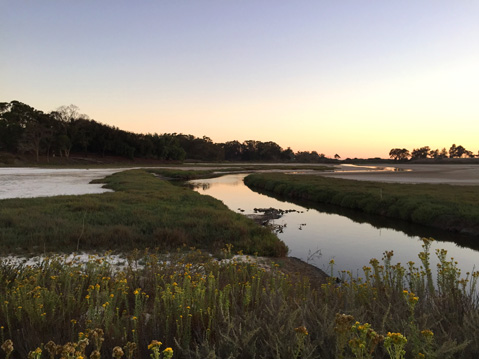Discovering Coal Oil Point
Profiles in UCSB’s Natural Reserve System

I arrived at Coal Oil Point Reserve an hour before the sun went down on a warm, gusty day. The bluff-top cypress and sage scrub were painted pink as I made my way to the shore, pausing briefly to watch surfers skip over the white-capped ocean and a great egret tiptoe around the Devereux Slough. Tourists and joggers meandered near a gateway and gravestone left by a British colonel and his Chicago wife 100 years ago. A quick descent to the beach started my trip along a four-mile loop that runs through each of the 158-acre reserve’s habitats, all of them crowded with a treasure trove of plants and animals.
First were snowy plovers. The tiny endangered birds kicked up puffs of sand as they sprinted from nearby dunes to feed on insects among the kelp. When they weren’t eating, they were hunkered down in shallow divots behind protective fencing, their brown, white, and black bodies well camouflaged between rocks and driftwood. A management program has boosted their numbers in recent years, and 45 chicks fledged this season, 15 more than average. Flutters of feet and wings seemed to always catch the corner of my eye.
A little farther down the beach, I headed back toward the slough and the trail that skirts its edge. Kneeling down in the dunes, I spied labyrinths of narrow tracks in the sand left by global dune beetles. A little farther on, the mingling sounds of wind and surf gave way to a gentle swaying of grass and leaves as I approached the heart of the estuary. Dusk settled in.
During normal years, the Devereux Slough is often filled bank-to-bank. This summer it’s been reduced to a ribbon of water flanked by chalky salt flats. But it’s still one of the best birding sites west of the Mississippi.
I picked out coots, grebes, cormorants, and terns, their bodies perfectly mirrored in the still water. I hoped to see a California quail, another population of species nursed back to health at Coal Oil Point, but no luck.
I took my time continuing on, enjoying the simple prettiness of the place and savoring my time alone there. I wondered why, after 10 years of living in Santa Barbara, I hadn’t explored it like this sooner. Signs along the path talked about Chumash history, restoration projects, and intertidal ecology. The sun was now so low only the tips of distant mountains were lit.
I passed the reserve’s small research station on my way back to my car. In the next couple of years, UCSB will create a new nature center. In the meantime, volunteers are always needed to lead tours, plant trees, and watch over the plovers. A flyer was posted nearby, and there was just enough light to read a phone number: 897-3703 for more information



